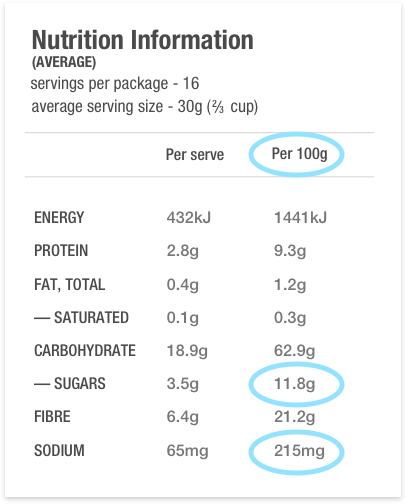How to read food labels
At Core we always talk about the benefits of eating real, whole, organic, grass fed foods. And there are absolute benefits in doing this. In an ideal world we would all have the time and energy to cook all our meals from scratch, with foods from our own garden or the local farmers market. But we also need to be realistic – not every meal is going to be cooked from scratch, and if it is then sometimes an ingredient or 2 might come from a packet or bottle. So we need to know how to read a food label…
How to read a food label
On every packet there will be the ingredients list and the nutritional panel.
Ingredients List
I always read a label starting with the ingredients list. Ingredients are listed from greatest to smallest by how much they weigh (including any added water) at the time they are added to the product.
Where there are small amounts of multi-component ingredients (under 5%) labels may list the composite ingredient only, e.g. tomato sauce, rather than listing the ingredients contained in the sauce itself. However, any additive within a composite ingredient, performing a function in the final food, e.g. a preservative, must be listed.
For food items I’m looking for sugars and hidden sugar names, then the types of oil used if any, then any preservatives, and names with numbers on them. Too many ingredients and any names that I can’t pronounce go back on the shelf.
Nutritional Panel
This is where things can get a little more complicated. I don’t usually look at the panel, but it is helpful to know what to look for if the product you’ve selected passes the ingredients list check.
Servings per package
Serving sizes are determined by food companies, which is why they vary so widely from product to product. And why they often seem so small compared to how much you’ll really eat! If you’re likely to eat more than one suggested serving at once, remember to take that into account when determining how much sugar, fat, sodium and so on you’re actually consuming.
Fats
Fats are broken down into total fat, and saturated fats listed separately.
We know that saturated fats are good, but check the ingredients label for the type of fats used in the product. Vegetable oils (canola, soybean, palm, corn, safflower, sunflower, cottonseed) are not good choices but are mostly used in processed/packaged foods. Incorporating healthy fats into your daily diet is important for good health, and will also keep you satisfied for longer.
Plus, foods that have had fat removed from them (low-fat yoghurt and the like) are usually pumped full of sugar to make up for lost texture and flavour. Don’t rely on the package’s nutritional claims that “low-fat” is a good thing, and trust your appetite instead.
If 20 grams of fat is listed in the ‘per 100g’ column, this means the product is 20% fat.
Sugars
Sugars are included as part of total carbohydrates, as well as being listed separately. The amount includes naturally occurring sugars combined with added sugars. (Hint: products with “no added sugar” nutrition claims may actually contain high levels of “natural” sugars.)
Use “sugars per serve” to determine how many teaspoons are in a serving by dividing the figure by 4.2 (the number of grams in a teaspoon). So, if there’s 21g of sugar in a serve, that comes out to five teaspoons.
And if there’s two servings in, say, that bottle of apple juice or carton of chocolate milk, you’ll need to double the sugar to determine how much you’re really consuming. (Keep in mind that the WHO guidelines recommend no more than 6–9 teaspoons of “free sugars” per day.)
Per 100g
You can use this column to figure out what percentage of the product each item is. If a product has 33g sugar per 100g, for example, that product is 33 per cent sugar. Which is about one-third sugar in total (visualise that!). Aim to stick to foods that are about 3-5 per cent sugar.
Be careful of sodium here, as this is often displayed in milligrams (mg). There are 1000 milligrams in a gram, so if you’re calculating this percentage you’ll have to divide the figure by 1000 first.



